woborn almshouse
woborn almshouse
Almshouse from 1476 to the present
 The
Woborn Almshouse
or hospital was
founded in
Yeovil under
letters patent
granted by King
Edward IV,
bearing the date 9th
November 1476,
in honour of St
George and St
Christopher, in
Silver Street,
Yeovil. It was
set up by John
Woborn and
Richard Huett,
chaplains and
benefactors, for
the salvation of
the soul of
William Woborn,
a minor canon of
St Paul's
Cathedral,
London, and
brother of John,
though what
connection they
had with Yeovil
is not known.
The
Woborn Almshouse
or hospital was
founded in
Yeovil under
letters patent
granted by King
Edward IV,
bearing the date 9th
November 1476,
in honour of St
George and St
Christopher, in
Silver Street,
Yeovil. It was
set up by John
Woborn and
Richard Huett,
chaplains and
benefactors, for
the salvation of
the soul of
William Woborn,
a minor canon of
St Paul's
Cathedral,
London, and
brother of John,
though what
connection they
had with Yeovil
is not known.
The deed of foundation set forth that it was to be for the support of six poor men and six poor women who were “single and chaste, and untainted by leprosy“. They were to be under the control of a Custos, or master, and two Wardens, who were to be elected annually from five or seven honest men of Yeovil nominated by the outgoing Custos and Wardens. Various orders and regulations were laid down for the government of the Almshouse and among the weekly doles specified were 12d for the vicar, 4d for the clerk, singing boys 1d each and 6d for the ringers. The priest of St John’s church was to have 1s 6d for reciting the names of the benefactors in the pulpit every Sunday and 1d for the crier for reciting their names in the town. It was ordained also that the Custos and Wardens should be changed each year and chosen from five or seven "of the most honestest and discreetest men" in the parish of Yeovil.
The male inmates were required to wear a red cross on their breasts in honour of St. George, who was joint patron with St. Christopher of the almshouse and this tradition survived into the early twentieth century and is seen above in the photograph of the almsman. The inmates were “to say daily one psalter of the Blessed Virgin, kneeling if their health would permit; on festivals they were to say the same psalter two or three times in succession, either standing, sitting or kneeling. Other prayers were ordered on special occasions for the souls of the founders and other persons, and the Custos and Wardens were to form a fraternity of the parishioners of Yeovil and other persons willing to contribute to the support of the almshouse.” This institution, which was often remembered in the wills of local testators, survived the Reformation.
The first time I have discovered an individual leaving a legacy of money to the residents of the Woborn Almshouse is in the will of William Hayne, dated 15 January 1558, in the fifth year of the reign of Queen Elizabeth. In his will, he wrote "Item I gyve and bequethe to the poore people of the Allmes house of Yevill aforsaide Yevelle xvijs iijd [seventeen shillings and three pence - around £350 at today's value] during the terme of xxiiij [twenty four] yeares next comynge in manner and forme followinge that ys to saye [word illegible] duringe the said terme [two words illegible] under the Condicion that yf the same poore people have Wekelie other iiijd [fourpence] out of the Land of the same allmeshouse over and above their Wekelie stipend and wages duringe the said terme of xxiiij [twenty four] yeares that they the said poore people shall [two words illegible] charytablie dyne together duringe the said terme to be paid out of my lands in Yevill Otherwise this my legacie unto them to be voide and of noo effecte"
The original Woborn Almshouse building was sited just behind the property that was to become the Pall Tavern, the site is occupied now by the Indian restaurant. The Pall Tavern, the Three Choughs Hotel, the George Inn and the Black Cock were for centuries owned by the Woborn Almshouse, among many other properties bequeathed down the centuries, and the rent of the buildings and land provided income for the Almshouse. Other properties owned by the Almshouse at the time of the 1846 Tithe Apportionment are tabulated below.
Mismanagement and misappropriation of the almshouse funds was part the Yeovil Charities Scandal at the beginning of the nineteenth century.
In the 1841 census six men, aged between 60 and 82, and six women aged between 68 and 90 were living at the almshouse. Two teenage girls and two teenage boys, both male servants, were also listed. In the 1851 census there were again six men, aged between 76 and 85, and six women aged between 64 and 79 living at the almshouse. No staff were resident but 17-year old Elizabeth Hawkins was listed as a 'nurse to mother', being 70-year old Naomi Hawkins.
In 1856 Daniel Vickery wrote of the almsmen and women “The weekly allowance is 4s each; 1s each at the Custos entering upon office; 1d each on St Mary Magdalene’s day; 4d each at Whitsuntide; 6d each on all Saints' Day and 2s 0d each at Christmas. They receive also some articles of clothing, and coals are found. The oldest almsman acts as chaplain and receives a salary of 20s a year; the bell ringer has 10s…. The present Alms-house is situated in a low, damp, and confined situation, and the Feoffees’ purpose, with the sanction of the Charily Commissioners, (before whom the charity now is) to erect a new building on a piece of ground belonging to the charity adjoining Trinity District Church.”
The medieval almshouse had become so ruinous by the 1850’s that the new Woborn Almshouse was built in 1860 at its present site. The almshouse already owned a small property on the southwest corner of Bond Street, with its junction. Behind this, and extending all the way to Peter Street, was a yard belonging to the almshouse. The small corner property and the neighbouring cottage were demolished and this land, together with the yard, became the site of the new almshouse building we see today.
The new building is of local cut and squared stone with Ham stone dressings with a Welsh slated roof and tall stone chimney stacks. It is a two-storied building with gables to each of the seven bays, bays, 1, 4 and 7 being wider and projecting. The centre bay, of one storey, was originally the hall or chapel. There are simple matching side elevations to both Peter Street and South Street.
In the 1881 census Adelaide Bennet was recorded as the Matron of the Almshouse along with her young niece and six male ‘inmates’ and six female ‘inmates’. The returns were identical in the 1891 census but with a different dozen 'inmates'.
Reorganisation in 1969 provided accommodation in eight self-contained flats and today the building contains both single and married people who are persons of good character who have resided in the 'ancient parish of Yeovil' for at least five years. Management of the Almshouse is by twelve trustees who still appoint from their number a Custos and two Wardens as provided by the original founders.
For a list of Woborn Almshouse properties and tenants click here.
MAP
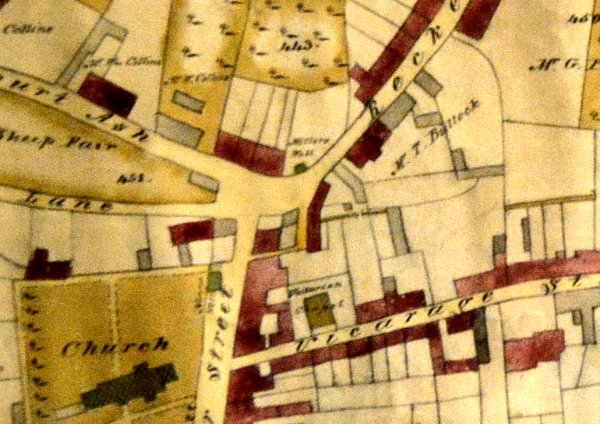
Edward Bullock Watts' 1806 map of Yeovil showing the junction of Sheep Lane / Court Ash / Reckleford / Silver Street (today's North Lane / Court Ash / Market Street / Silver Street). At centre, is the original Pall Tavern (before it was rebuilt in 1836) with a narrow alley running alongside leading to the original (and slightly bent on plan) Woborn Almshouse that also faces Miller's Well at its northern end.
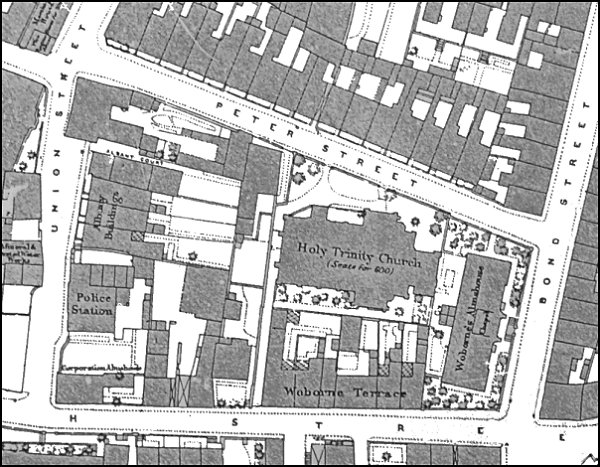
Map based on the 1886 Ordnance Survey showing the rebuilt Woborn Almshouse at bottom right on the corner of Bond Street and South Street.
Land Holdings
As well as owning several inns, mentioned above, and other properties in the town, the almshouse also owned several plots of land, again with the annual income from rents going towards the running costs of the almshouse. Below are tabulated the lands owned by the Almshouse at the time of the 1846 Tithe Apportionment.
| Owner | Occupier | No | Parcel |
| Yeovil Almshouse | Buck, William | 1465 | In West Field |
| Yeovil Almshouse | Frost, George | 1311 | Whitepole |
| Yeovil Almshouse | Marsh, Charles | 873 | In Part Beachams Close |
| Yeovil Almshouse | Parsons, Charles | 615 | In Lower Northover |
| Yeovil Almshouse | Symes, William | 1233 | Roy |
| Yeovil Almshouse | Symes, William | 1234 | Roy |
| Yeovil Almshouse | Symes, William | 1235 | Roy |
| Yeovil Almshouse | Symes, William | 1236 | Roy |
| Yeovil Almshouse | Tomkins, Edwin | 1033 | Brickyard Lane |
| Yeovil Almshouse | Watts, Edward | 1427 | Hide Plot |
For a complete list of Almshouse properties, rents and tenants click here.
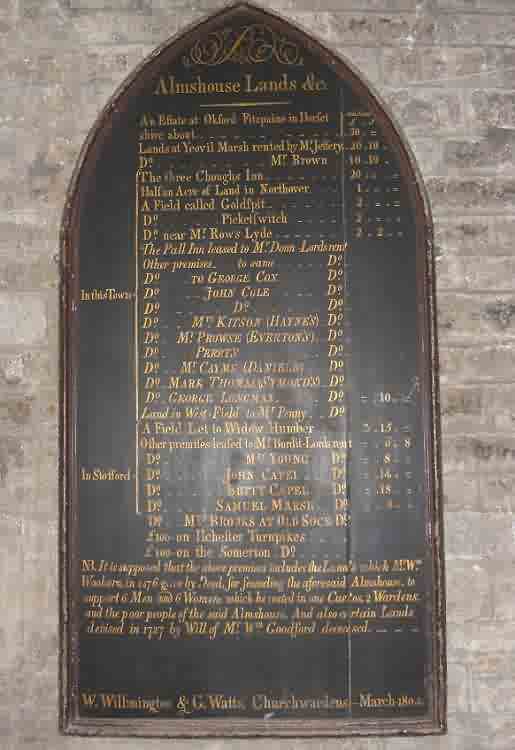
One of four charity boards in St John's church dating to 1804. This board lists the land holdings of the Woborn Almshouse and of special note is that it owned both the Three Choughs and the Pall Inn.
gallery

A nice piece of ephemera - the annual gas bill for the almshouses dated Lady Day (25 March) 1869 in the sum of £2 1s 3d (about £190 at today's value).
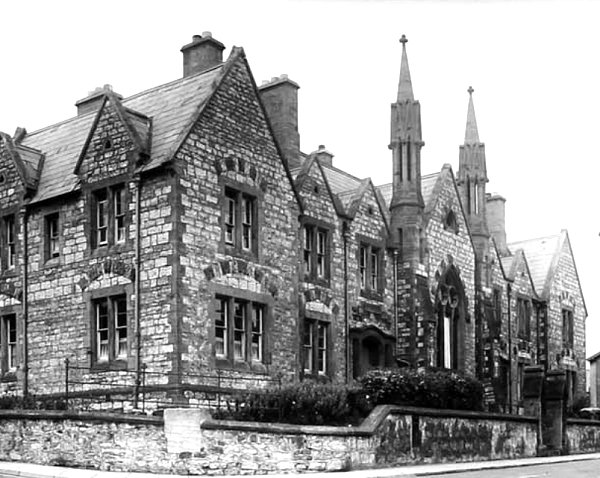
This photograph
features in my
book 'Yeovil
From Old
Photographs'
The Woborn Almshouse was originally adorned with a pair of pinnacles, similar to those on the church behind it. The pinnacles had been removed by the end of the 1950s.
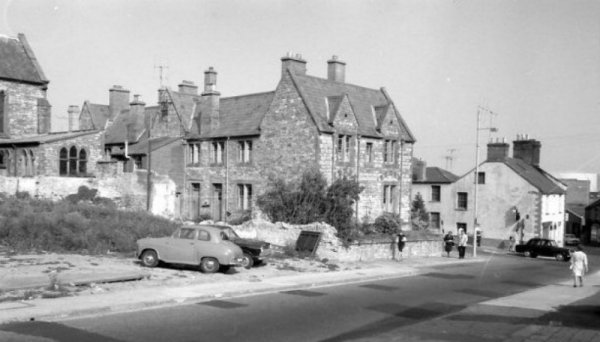
A sight not seen today - the back of Woborn Almshouse viewed from South Street, The photograph was taken around 1960 shortly after Woborn Terrace was demolished.

Courtesy of
Chris Rendell
Bond Street photographed from South Street in 1984.

This plaque is affixed to the wall of what it now the stairwell (originally the chapel) of the Woborn Almshouse. At the time of the rebuilding, the plaque notes that the Custos was the Vicar, the Revd. RIF Thomas and the Wardens were Thomas Messiter and George Bullock. The Trustees were George Harbin, Henry Goodford, John Ryall Mayo, Robert Tucker, Frederick Greenham and William Shorland. Photographed in 2019.
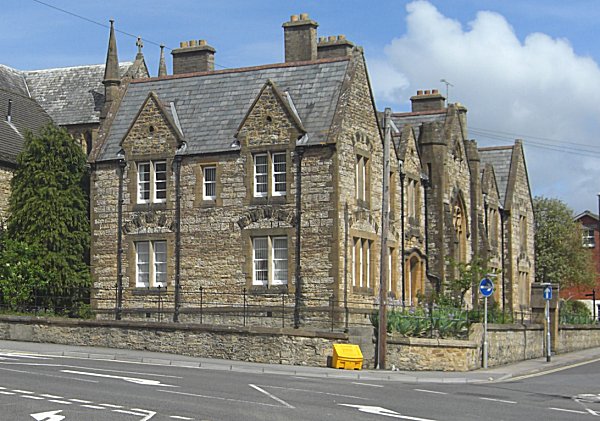
Woborn Almshouse seen from Park Street. Photographed in 2013.
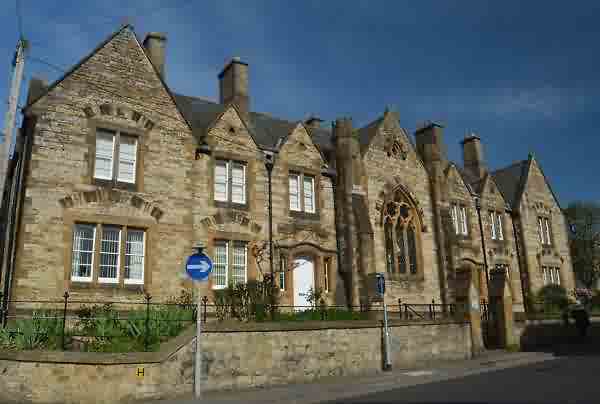
This photograph
features in my
book "Yeovil
In 50 Buildings"
The Bond Street elevation seen from South Street. Photographed in 2017.

The Bond Street elevation seen from Bond Street. Photographed in 2013.

A datestone set in the wall above the entrance. Photographed in 2013.